Nikon D5 Continuous Shooting With External Flash
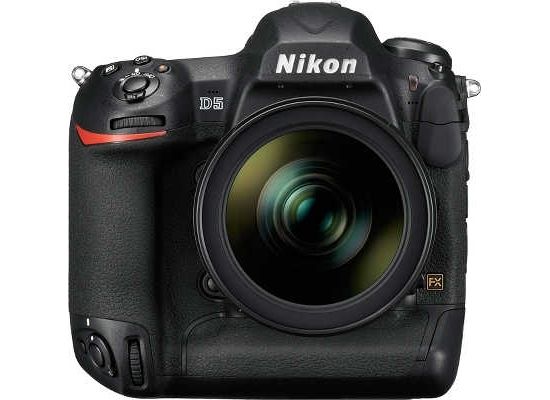
Introduction
The D5 is Nikon's latest flagship professional DSLR, sitting right at the top of its line-up and representing an upgrade from 2014's D4S. It's no surprise to see Nikon announcing a new camera in this year with big sporting tournaments, especially the Olympics, on the horizon.
Nikon has kept more or the less the same body design for the D5 as its predecessor, but there's been some significant improvements under the bonnet which should make this a very, very appealing camera for professional photographers - especially those in the news and sports camp.
There's been an increase in resolution, up from the 16 million pixels of the D4S, the Nikon D5 sports a 20.8 million pixel FX-format (full-frame or 35mm) CMOS sensor. Although it's true that there are sensors with much higher pixel counts on the market (Nikon's own D810 has 36 million), it's likely that professionals will welcome this relatively modest increase. A huge resolution equates to huge file sizes, which can be a drawback to news and sports photographers working in the field, while an increased resolution is likely to be detrimental to low light noise performance.
Speaking of which, Nikon's incredibly clever engineers have worked some magic when it comes to the ISO range of the D5. The standard range of the camera is ISO 100 - 102,400, up by two stops when compared to the D4S which had a native range of ISO 100 - 25,600. The big headlines however were generated by the expansion settings which Nikon offers - the top speed being an incredible, and frankly unbelievable sounding, 3,280,000.
There's also a new 153-point AF system, which includes 99 cross-type points which are more sensitive. The D4S by contrast had 51 AF points. Nikon has included an EXPEED 5 processing engine, which boosts the frame rate of the camera up to 12fps (from 11fps with the D4S) - further good news is that there is a burst depth of up to 200 raw files when writing to an XQD card. AF tracking has also been improved, along with a new ASIC unit which has been included to provide high performance with autofocus.
The Nikon D5 will be available in two variants, one which features double CF card slots, and one which features XQD slots. Although many professional photographers may have lots of legacy CF cards, if they want to take advantage of the fast speeds on offer from the D5, they will need the XQD version. For the first year of sales, Nikon will be shipping the D5 with a free XQD card and reader.
On the back of the Nikon D5 there's a 3.2-inch, 2359k-dot TFT screen which, in a reasonably big difference from the D4S (and an interesting step for pro-level cameras), is touch-sensitive.
Finally, another new improvement for the D5 is the addition of 4K video recording. It is one of only two Nikon DSLRs to offer such functionality - the other being the Nikon D500. However, 4K video recording is limited to recording just three minutes. In can record full HD video at 1080p as well.
The Nikon D5 DSLR is available for a suggested retail price of £5,199.99/€6,989.00/$6,499.95 in two different versions, with either dual XQD card slots or dual CF card slots.
Ease of Use
Nikon knows that many potential D5 owners will be current D4S owners, and it seems likely that for this reason, Nikon has kept roughly the same body size, shape and layout. So, if you're a professional who has been using the D4S for the past couple of years, you don't have to worry about getting used to a new way of working if you upgrade to the new model.
That said, if you look closely, you'll see that the grips on the front and back of the Nikon D5 have been reshaped ever so slightly to make the camera feel a little more comfortable in your hand if you're using it for long stretches of time. Considering the weight and size of the D5, it sits nicely in your hand, with a good placement of dials and buttons within easy reach or your forefingers and thumb. The eyepiece cup around the viewfinder is also a very slightly different shape, too.
Unlike cameras a little bit down Nikon's line-up, the D5 (like the D4S) has an inbuilt portrait format grip. There are two shutter release buttons - one on the landscape grip, another on the portrait grip. A small function button is found behind the vertical shutter release - you can assign it to a number of different functions, or you could match it to the ISO functionality of the button behind the landscape shutter release. There are also duplicate front and rear dials which correspond to the same dials around the landscape shutter release. There's also two AF-on buttons which are placed in easy reach of your thumb - you can use them for back-button focusing.
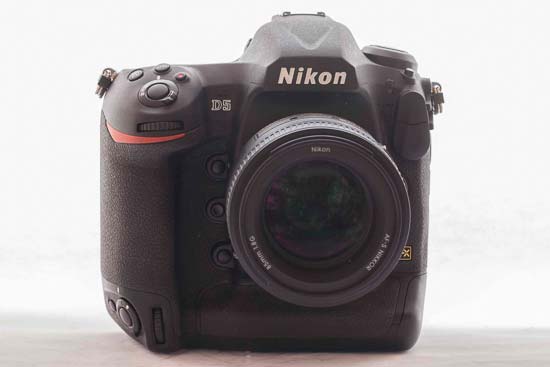 |
| Front of the Nikon D5 |
Like with the D4S, there are two textured small joysticks which you can use to select an AF point. You can also use them as AE Lock buttons. There are two so that again you can use either of them depending on which orientation you're holding the camera. It's an intuitive little joystick to use, and as it falls neatly under your thumb when holding the camera it's very quick to change the point you need. You'd have to give the joystick a reasonably hard push by accident to change a point when you didn't want to - and hold it down to move the point across further than one point. You also have the option to use an eight way controller just underneath the joystick to set your focus point, but it's pretty small and not that comfortable to use.
Underneath the 8-way pad is a lock button which allows you to lock the focus point on the one you have currently selected. This is useful if you don't want to accidentally change the focus point, either by accidentally touching the focusing joystick, or absent mindedly.
For the Nikon D5 there is another way to set the autofocus point - but only if you're shooting in Live View. You can now use the screen as it is touch sensitive. Simply switch the camera to shooting in Live View (there's a dedicated button near the screen) and you can tap on screen where you want the point to be. While it's true that the majority of photographers will be using the viewfinder to compose, using the screen is useful in certain applications, such as when shooting macro subjects.
The D5 has a new Multi-CAM 20K autofocus sensor module which features 153 focus points, however only 55 of the points are available for selection - the rest are used as supporting AF points. There are different AF modes to choose from. You can use either Single-point AF, 25-, 72- or 153-point dynamic area AF, 3D tracking, group-area AF or auto-area AF. To choose which mode to use, you press a button near the lens mount, and use the front scrolling dial to move through the different options. Hold down the same button and scroll the rear dial to choose between AF-S (single), and AF-C (continuous). An AF/MF switch around the AF mode selector button allows to switch quickly between autofocusing and manual focusing.
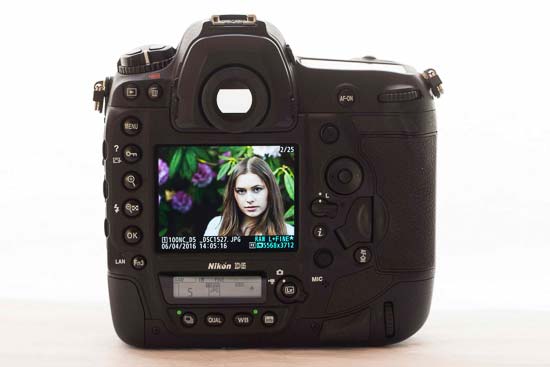 |
| Rear of the Nikon D5 |
Nikon seems to have improved continuous focusing over the D4S - which is more good news for sports and action photographers. Using the D5 in tricky lighting conditions and with a 300mm f/4 lens which is not known for its superlative continuous focusing performance, the D5 was able to keep up with moving figures extremely admirably. Furthermore, the increase in the buffer size (when using XQD cards) is bound to impress professional sports photographers - anybody shooting athletics at the Olympics is going to have plenty of frames to choose from. As with the D4S, you can choose to shoot in "Raw S" to produce a smaller file than the full resolution gives which can extend your continuous shooting even further and make it easier (in other words, quicker) to transfer images.
Autofocusing is designed to work in conditions as dark as -4EV for the more sensitive cross-type sensors. This gives you great scope to work in a variety of lighting conditions, and the Nikon D5 really delivers well, locking onto subjects in dark conditions quickly and easily without hunting around - news and reportage photographers who are working with natural low light at nighttime should really appreciate this. In terms of low light there's a definite and noticeable improvement from the already extremely capable D4S.
Going back to the Live View button - this is encircled by a two-way Live View mode selector, in essence to give you the choice between movie live view and stills live view. You can choose "silent live view" from the main menu. Once the mirror is raised you won't hear a peep from the camera, with the picture taken in completely silence. However, if you choose to use this, you'll be barred from shooting in raw format and have the resolution restricted. However, the size you're left with is big enough for printing at small sizes, so news photographers may find it useful in certain situations where any kind of audible noise is severely restricted.
You can also use the standard Live View quiet mode if you want to shoot at higher resolutions, or in raw format. This will move the mirror out of the way, but you'll still have the sound of the shutter when you take a shot.
There's plenty of other buttons on the back, top and front of the Nikon D5, most of which will be familiar to current D4S users. However, for those who are moving to the D5 for the first time, we'll look at some of the highlights. To the right of the lens mount you'll see there's three function buttons - these can be customised to control different functions depending on your preference from the main menu.
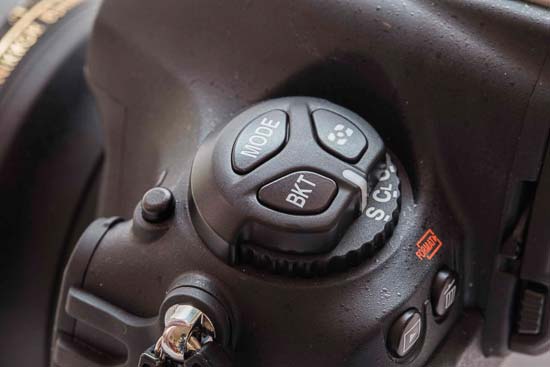 |
| Top of the Nikon D5 |
On the top left of the camera is where you can change the shooting mode (P, A, S, M - unsurprisingly there's no auto on offer here), drive mode (Single, Continuous Low, Continuous High, Quiet, Timer, Mirror Up), bracketing mode, and metering mode.
Moving to the back of the Nikon D5, and towards the bottom of the camera you'll find you're able to change image quality settings and white balance. The buttons overall have been designed to give professional photographers quick access to almost every setting, and although it takes some time to get to know the layout and what every button does, once you do, it seems sensible and quick.
The screen on the back of the D5 is fixed, but there is touch sensitivity for the first time. It's also seen a bump in resolution - there's now 2359k dots, whereas the D4S had 921,000. The touch sensitivity isn't available for every facet of camera option, but it is a usable extra. You can use it to set autofocus point in Live View, but perhaps more appealing to professional photographers is the option to swipe through images and pinch to zoom - it makes checking that you've got the vital shot just that little bit quicker. It would perhaps have been nice if you could use the screen to select menu options, though.
There's now a wealth of movie shooting options available for the Nikon D5. There's not only 1080p (full HD) at a variety of frame rates (24p, 25p, 50p, 60p) along with some crop modes, but there is now 4K video recording. Nikon has restricted the D5's ability to record 4K to three minutes, which although will be a little disappointing for some, for others, it may be all you need.
As you would expect from a camera at this level, you are afforded manual control over video recording. When shooting at Full HD, you'll be able to shoot for as long as 29 minutes 59 seconds. Despite the fact that 4K has been included here, it feels more like a bonus for stills photographers who may want to shoot the odd video, rather than something which is designed to appeal especially to videographers, which makes sense given Nikon's heritage.
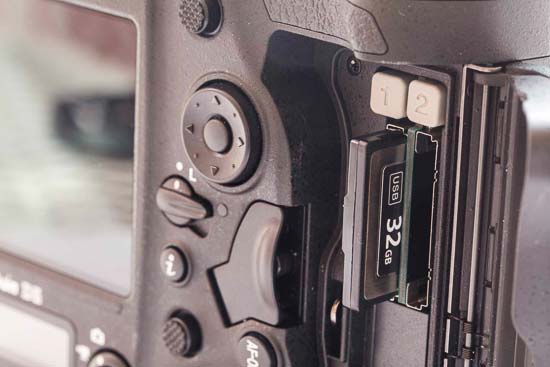 |
| Memory Card Slots |
The D5's optical viewfinder gives 100% frame coverage and is bright and clear, giving an excellent view of the scene. If you wear glasses, you should also find this particular viewfinder works well. Just like the D4S, there's a Type B BriteView Clear Matte Mark IX screen with AF area brackets - a framing grid can also be displayed if you like (from the custom menu). An additional bonus is the fact that the viewfinder eyepiece is fluorine coated, which means it repels dust, water droplets, oil, mud and other liquids - making it ideal when you need to shoot in tough conditions, such as pouring rain.
There continues to be no top-end professional DSLRs which offer Wi-Fi inbuilt into their body - which is a shame considering the price point. Wi-Fi connectivity would be very useful for news photographers who need to urgently file pictures, but it's been suggested that a Wi-Fi transmitter would struggle to work when placed inside the rugged metal body of something like the D5.
As with the D4S you can purchase a Wt-5 wireless transmitter separately - this is an expensive, yet perhaps vital purchase for any news photographer. It would be nice if the engineers at Nikon could think of a way around the Wi-Fi problem that doesn't include dishing out an extra £600 for a transmitter. In better nows however is that the camera's USB port is now USB 3.0, while the D4S has a slower USB 2.0 port, which makes transferring images across, or tethering, much quicker.
The Nikon D5 uses the same battery as the D4S - the EN-EL18a, which is good news for D4S owners who may have already purchased additional batteries that they can transfer across to new kit. A new EXPEED processing engine helps to boost an already impressive 3,020 shots up to a quoted 3,780 shots per charge for the D5. Needless to say, we didn't encounter any problem with dead batteries during our testing, but if you're a sports photographer shooting 12fps, you may want to make sure you keep a spare to hand.
Just like the D4S, the Nikon D5 is a very very capable camera, with a good degree of improvements from the predecessor. Autofocusing is quick in a wide range of conditions, seemingly no matter what lens is attached to it. Shot to shot times are also super quick, and there's near instant start up time and almost no shutter lag to boot.
Image Quality
It would be fair to say that we weren't expecting anything less than excellent results from the Nikon D5, and happily it hasn't disappointed.
The Nikon D4S was already a great performer, and the D5 builds on this fantastic legacy, especially when it comes to low light shooting - the main area where Nikon has improved actual image quality for the new generation.
You can shoot at a ridiculously high equivalent of over 3 million ISO if you want to. You probably won't want to because the images are very painterly, missing a lot of detail and have a magenta hue. But, take a minute to register that it is capable of shooting at such a ridiculously high speed though. Just as you'll probably never use the top speed of your car, but you expect good performance at lower speeds, the D5 excels at speeds that other cameras can only dream of.
I was able to get usable images entirely throughout the Nikon D5's native sensitivity range. Even stretching to Hi1 (204,800) and Hi2 (409,600) produced some usable images if you're only printing them small - just as the average news or reportage photographer is going to be. In other words, this is a dream for photographers who can't always rely on good light.
Detail is kept well throughout the range, and it only really begins to noticeably drop off significantly from around ISO 102,400 - in other words, the camera's top native sensitivity. Noise is very well controlled JPEG images, producing a natural effect that's not too soft, but if you need to bring back some more detail, you will be able to use the raw format files - but with increased noise.
Colours are nice and vibrant straight from the camera when using the standard picture style, perhaps erring a little towards over saturation. You can shoot in a different picture style if you prefer a more muted look, while the raw format images are a lot flatter - which is good scope for post production work.
There are three automatic white balance presets which you can use, each depending on your personal preference. There's a standard, one which keeps cooler tones, and a third which keeps warmer tones. The standard setting does a good job of striking a good balance between the two, with the warmer setting erring on the side of yellow tones when shooting under artificial lights - but preserving warmer skin tones and natural tones when shooting natural daylight.
Noise
Here are some 100% crops which show the noise levels for each ISO setting for both JPEG and RAW files.
| JPEG | RAW |
| ISO 50 (100% Crop) | ISO 50 (100% Crop) |
 | 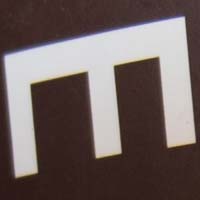 |
| ISO 64 (100% Crop) | ISO 64 (100% Crop) |
 | 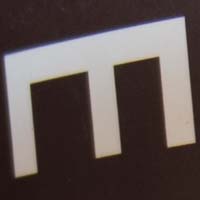 |
| ISO 80 (100% Crop) | ISO 80 (100% Crop) |
 | 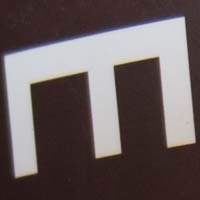 |
| ISO 100 (100% Crop) | ISO 100 (100% Crop) |
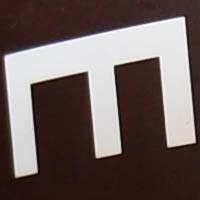 |  |
| ISO 200 (100% Crop) | ISO 200 (100% Crop) |
 | 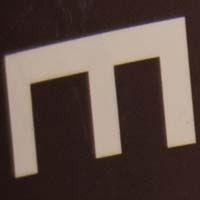 |
| ISO 400 (100% Crop) | ISO 400 (100% Crop) |
 | 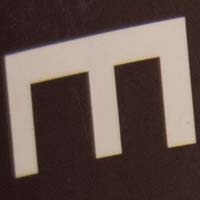 |
| ISO 800 (100% Crop) | ISO 800 (100% Crop) |
 | 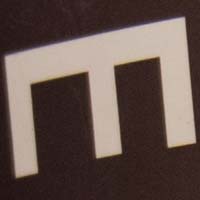 |
| ISO 1600 (100% Crop) | ISO 1600 (100% Crop) |
 | 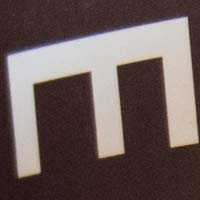 |
| ISO 3200 (100% Crop) | ISO 3200 (100% Crop) |
 | 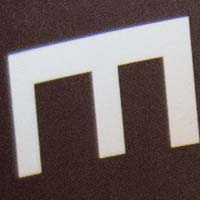 |
| ISO 6400 (100% Crop) | ISO 6400 (100% Crop) |
 | 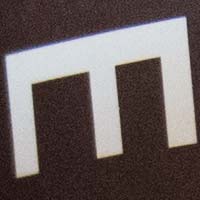 |
| ISO 12800 (100% Crop) | ISO 12800 (100% Crop) |
 | 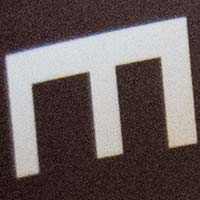 |
| ISO 25600 (100% Crop) | ISO 25600 (100% Crop) |
 | 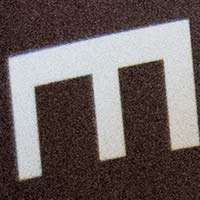 |
| ISO 51200 (100% Crop) | ISO 51200 (100% Crop) |
 | 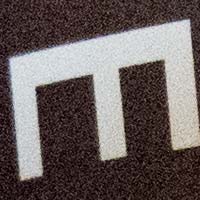 |
| ISO 102400 (100% Crop) | ISO 102400 (100% Crop) |
 | 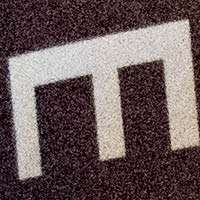 |
| ISO 204800 (100% Crop) | ISO 204800 (100% Crop) |
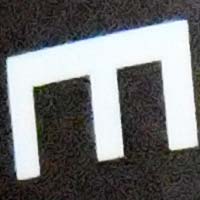 | 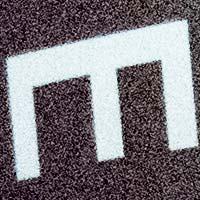 |
| ISO 409600 (100% Crop) | ISO 409600 (100% Crop) |
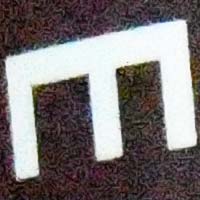 |  |
| ISO 819200 (100% Crop) | ISO 819200 (100% Crop) |
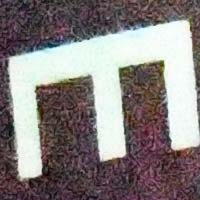 | 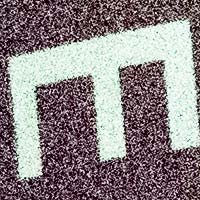 |
| ISO 1638400 (100% Crop) | ISO 1638400 (100% Crop) |
 |  |
| ISO 3276800 (100% Crop) | ISO 3276800 (100% Crop) |
 |  |
Sample Images
This is a selection of sample images from the Nikon D5 camera, which were all taken using the 20.8 megapixel Fine JPEG setting. The thumbnails below link to the full-sized versions, which have not been altered in any way.
Sample RAW Images
The Nikon D5 enables users to capture RAW and JPEG format files. We've provided some Nikon RAW (NEF) samples for you to download (thumbnail images shown below are not 100% representative). The lion pictures were taken by Polly Thomas, and the sports pictures by Matthew Horwood.
Sample Movies & Video
This is a sample movie at the highest quality setting of 3840x2160 pixels at 30 frames per second. Please note that this 17 second movie is 242Mb in size.
This is a sample movie at the highest quality setting of 1920x1080 pixels at 25 frames per second. Please note that this 19 second movie is 55Mb in size.
Product Images
 |
| Front of the Nikon D5 |
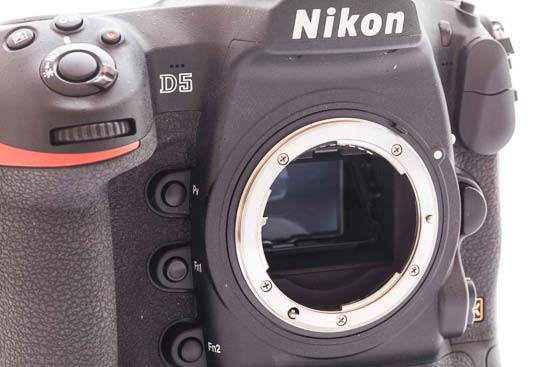 |
| Front of the Nikon D5 |
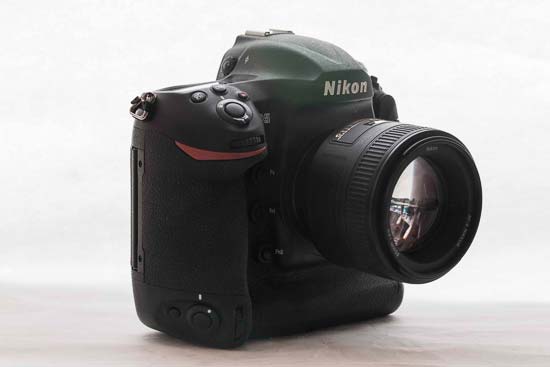 |
| Side of the Nikon D5 |
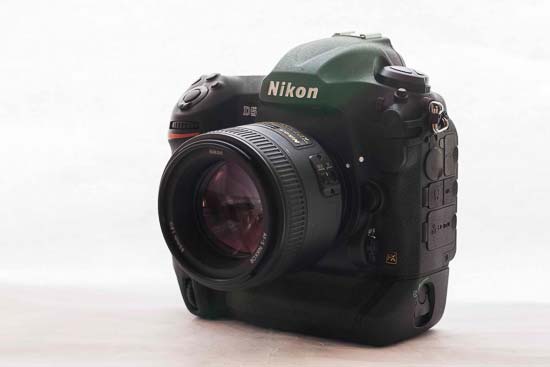 |
| Side of the Nikon D5 |
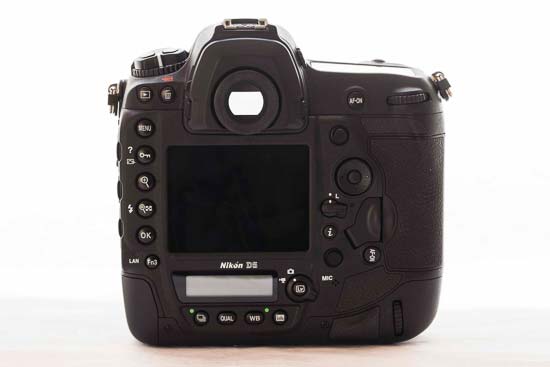 |
| Rear of the Nikon D5 |
 |
| Rear of the Nikon D5 / Image Displayed |
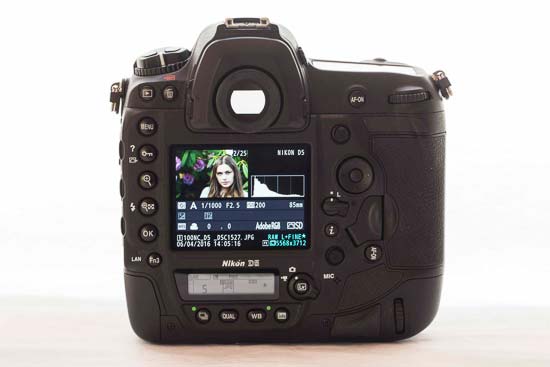 |
| Rear of the Nikon D5 / Image Displayed |
 |
| Rear of the Nikon D5 / Shooting Menu |
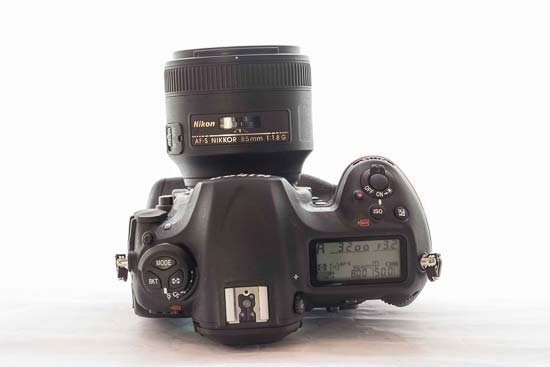 |
| Top of the Nikon D5 |
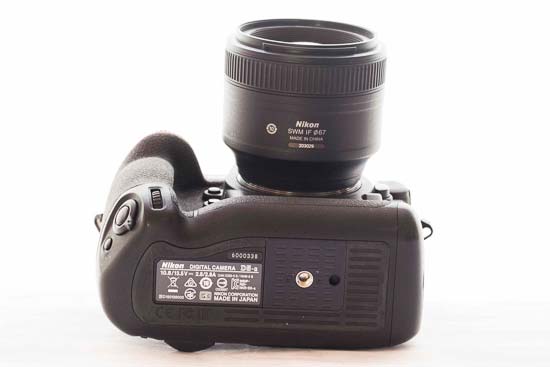 |
| Bottom of the Nikon D5 |
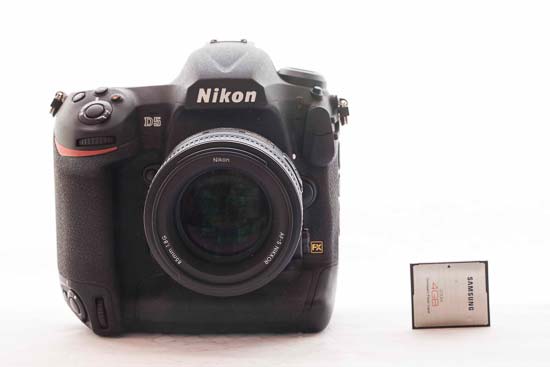 |
| Front of the Nikon D5 |
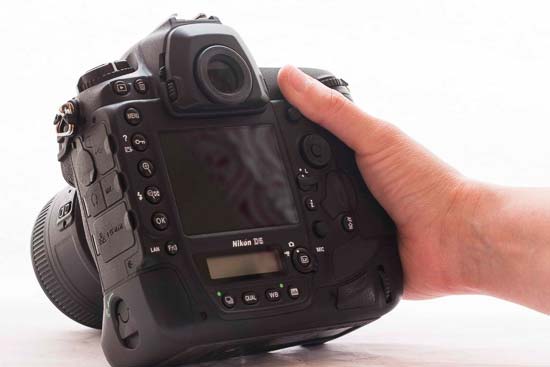 |
| Rear of the Nikon D5 |
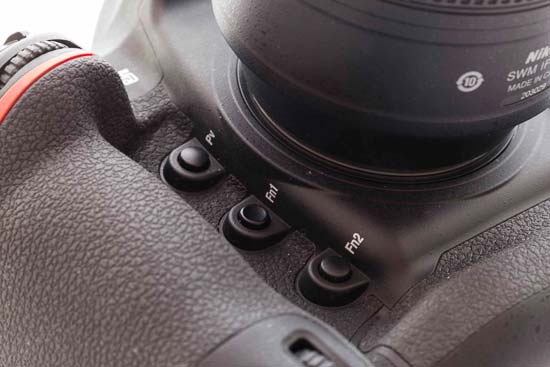 |
| Front of the Nikon D5 |
 |
| Top of the Nikon D5 |
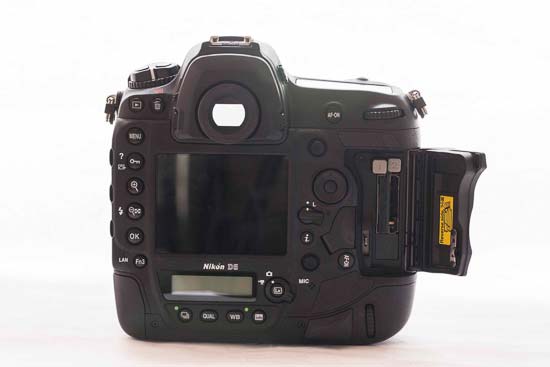 |
| Memory Card Slots |
 |
| Memory Card Slots |
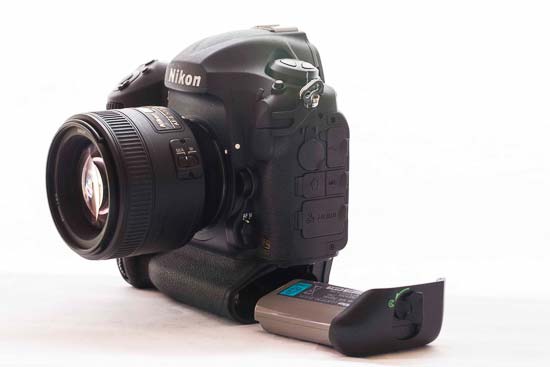 |
| Battery Compartment |
Conclusion
Nikon has probably already done enough to tempt professional photographers to place a pre-order by releasing the specs of the D5 alone. However, it's good to have it confirmed that those promising specs really do deliver as we have found after spending a significant amount of time with the D5.
The headline feature is the incredible new ISO range, and although it's pretty unlikely you'll want to use the extraordinarily high top expansion setting, it means that others, at a lower speed, are very, very good. Those who frequently shoot in low light, can shoot at super fast ISOs - something which could be invaluable for news photographers and photojournalists - without worrying about degradation of image quality.
There's also been a noticeable in the accuracy and speed of tracking autofocus, while the slight improvement of continuous shooting speeds (up to 12fps) make it an ideal camera for sports photographers - with plenty of big tournaments and sporting events this year it makes sense that the Nikon D5 is emerging now.
Nikon clearly believes that the future is XQD cards, dispensing with the one of each setup of the Nikon D4S and going for an either/or setup. If you want the fastest speeds and the deep buffer, then you'll be going for the XQD version. Those who have a big crop of CF cards can take comfort in the fact that a card and reader will be included in shipments of the D5 in the first year. Perhaps if you don't shoot a lot of action, or have coped fine with the D4S, you may be tempted to go for the CF card version - but you might have to question why you are upgrading in the first place if not for the speed improvements.
It continues to be a shame that nobody seems to have found a way to implement in-body Wi-Fi for professional cameras at this level. For photojournalists working in the field it's indispensable, so we hope that Nikon (et al) are working on a solution for that as we speak.
Implementing a touchscreen on a professional camera of this standard is an interesting move - plenty of companies seem to believe that professional photographers aren't interested in touch technology. However it has its uses when checking critical focus, and it's a nice addition that many will appreciate.
4K is the buzzword technology at the moment, and it feels a little like Nikon has jammed that on the D5 just so it can say that it has it. The fact that the D5 can only shoot for three minutes at a time makes it a little less usable than we'd like, but it is handy for recording snippets of video - ideal for stills photographers who want to add a bit of video to their offering, but not for videographers who want something as their main camera.
If you've already got a D4S, upgrading to the D5 will feel like an obvious decision. Some will be wondering if it's worth the upgrade, considering the high asking price. The answer is yes - probably, but as with anything, it depends on the kind of photography you shoot. If you're a photographer who has any use for super high ISO speeds and fast autofocus (sports, news, action, weddings), then the upgrade is worth it - while if you're somebody who uses their camera mainly for subjects in good light, such as portraits and landscapes, you may be a little more reticent to splash out just yet.
Further good news is that the introduction of a new model pushes down the price of the older one, and increases the likelihood of finding second hand models on the market. The D4S is still an excellent camera, so if you're on a budget, don't necessarily be put off by the fact that a newer version is available.
Overall, Nikon has produced a superb camera here with the D5. There's enough familiarity to make existing Nikon D4S users feel at home, but there's enough new features to justify the upgrade. And those low light photos - just wow.
| Ratings (out of 5) | |
|---|---|
| Design | 5 |
| Features | 4.5 |
| Ease-of-use | 5 |
| Image quality | 5 |
| Value for money | 4 |
Main Rivals
Listed below are some of the rivals of the Nikon D5.
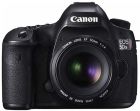
The Canon EOS 5DS R DSLR boasts a massive 50 megapixel sensor with a low-pass cancellation filter to maximise the sharpness of the camera's sensor. Does the brand new Canon 5DS R offer the best image quality from a DSLR? Read our detailed Canon EOS 5DS R review to find out...
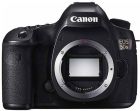
The EOS 5Ds DSLR camera has finally arrived, boasting a massive 50 megapixel sensor and proven design. Does the brand new Canon 5Ds offer high enough image quality to justify its £2999 / $3699 asking price? Read our detailed Canon EOS 5Ds review with full-size JPEG, Raw and video samples to find out...
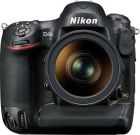
The new D4s is Nikon's new flagship DSLR camera for professional photographers. Aimed at sports, press and nature photographers, the 16 megapixel D4s builds on the success of the previous D4 camera with a wealth of improvements. Can the Nikon D4s possibly justify its eye-watering £5,199.99.99 / €6,199.00 / $6,499.95 price-tag? Find out by reading our Nikon D4s review...
The Sony A7R II is a hotly-anticipated full-frame compact system camera that promises to outclass the DSLR competition. Is this the best full-frame camera on the market? Read our Sony A7R II review to find out...
Review Roundup
Reviews of the Nikon D5 from around the web.
The Nikon D5 is Nikon's top of the range high-speed professional Digital SLR, with up to 14fps continuous shooting, 4K video recording, a new 20-megapixel full-frame sensor, and an ISO speed that goes all the way up to 3.2million! The Nikon D5 updates the Nikon D4s, which was released 2 years ago, and features a built-in ethernet connection for rapid image transfer.
Read the full review »
Specifications
-
-
Type
-
Single-lens reflex digital camera
-
-
-
Lens mount
-
Nikon F mount (with AF coupling and AF contacts)
-
-
-
Image sensor
-
FX, CMOS, 35.9 mm x 23.9 mm
-
-
-
Total pixels
-
21.33 million
-
-
-
Dust-reduction system
-
Image sensor cleaning, Image Dust Off reference data (Capture NX-D software required)
-
-
-
Effective pixels
-
20.8 million
-
-
-
Image size (pixels)
-
FX (36 x 24) image area, (L) 5568 x 3712, (M) 4176 x 2784, (S)2784 x 1856, 1.2 x (30 x 20) image area, (L) 4640 x 3088, (M) 3472 x 2312, (S) 2320 x 1544, DX (24 x 16) image area, (L) 3648 x 2432, (M) 2736 x 1824, (S) 1824 x 1216, 5 : 4 (30 x 24) image area, (L) 4640 x 3712, (M) 3472 x 2784, (S) 2320 x 1856, FX-format photographs taken during movie recording at a frame size of 1920 x 1080 or 1280 x 720, (L) 5568 x 3128, (M) 4176 x 2344, (S) 2784 x 1560, DX-format photographs taken during movie recording at a frame size of 1920 x 1080 or 1280 x 720, (L) 3648 x 2048, (M) 2736 x 1536, (S) 1824 x 1024, Photographs taken during movie recording at a frame size of 3840 x 2160: 3840 x 2160 Photographs taken during movie recording at a frame size of 1920 x 1080 crop: 1920 x 1080
-
-
-
Storage file formats
-
NEF (RAW): 12 or 14 bit (lossless compressed, compressed, or uncompressed); large, medium, and small available (medium and small images are recorded at a bit depth of 12 bits using lossless compression), TIFF (RGB), JPEG: JPEG-Baseline compliant with fine (approx. 1 : 4), normal (approx. 1 : 8), or basic (approx. 1 : 16) compression; optimal quality compression available, NEF (RAW)+JPEG: Single photograph recorded in both NEF (RAW) and JPEG formats
-
-
-
Picture Control System
-
Standard, Neutral, Vivid, Monochrome, Portrait, Landscape, Flat, selected Picture Control can be modified; storage for custom Picture Controls
-
-
-
Storage media
-
XQD, CompactFlash (CF) (Type I, UDMA compliant)
-
-
-
Dual card slot
-
2 XQD cards or 2 CompactFlash (CF) cards, Slot 2 can be used for overflow or backup storage or for separate storage of copies created using NEF+JPEG; pictures can be copied between cards.
-
-
-
File system
-
DCF 2.0, Exif 2.3, PictBridge
-
-
-
Viewfinder
-
Eye-level pentaprism single-lens reflex viewfinder
-
-
-
Frame coverage
-
FX (36 x 24): Approx. 100% horizontal and 100% vertical, 1.2 x (30 x 20): Approx. 97% horizontal and 97% vertical, DX (24 x 16): Approx. 97% horizontal and 97% vertical, 5:4 (30 x 24): Approx. 97% horizontal and 100% vertical
-
-
-
Magnification
-
Approx. 0.72 x (50 mm f/1.4 lens at infinity, -1.0 m-1)
-
-
-
Eyepoint
-
17 mm (-1.0 m-1; from center surface of viewfinder eyepiece lens)
-
-
-
Diopter adjustment
-
-3 to +1 m-1
-
-
-
Focusing screen
-
Type B BriteView Clear Matte Mark IX screen with AF area brackets (framing grid can be displayed)
-
-
-
Depth-of-field preview
-
Yes, Pressing Pv button stops lens aperture down to value selected by user (A and M modes) or by camera (P and S modes)
-
-
-
Lens aperture
-
Instant return, electronically controlled
-
-
-
Compatible lenses
-
Compatible with AF NIKKOR lenses, including type G, E, and D lenses (some restrictions apply to PC lenses) and DX lenses (using DX 24 x 16 1.5 x image area), AI-P NIKKOR lenses, and non-CPU AI lenses (exposure modes A and M only). IX NIKKOR lenses, lenses for the F3AF, and non-AI lenses can not be used. The electronic rangefinder can be used with lenses that have a maximum aperture of f/5.6 or faster (the electronic rangefinder supports 15 focus points with lenses that have a maximum aperture of f/8 or faster, of which 9 points are available for selection).
-
-
-
Shutter type
-
Electronically-controlled vertical-travel focal-plane mechanical shutter; electronic front-curtain shutter available in mirror up release mode
-
-
-
Shutter speed
-
1/8000 to 30 s, in steps of 1/3, 1/2, or 1 EV, bulb, time, X250
-
-
-
Flash sync speed
-
X = 1/250 s; synchronizes with shutter at 1/250 s or slower
-
-
-
Release mode
-
S (single frame), CL (continuous low speed), CH (continuous high speed), Q (quiet shutter-release), Self-timer, MUP (mirror up)
-
-
-
Frame advance rate
-
12 fps, up to 10 fps (CL); 10–12 fps, or 14 fps with mirror up (CH); or 3 fps (quiet continuous mode)
-
-
-
Self-timer
-
2 s, 5 s, 10 s, 20 s; 1 to 9 exposures at intervals of 0.5, 1, 2, or 3 s
-
-
-
Metering method
-
Matrix: 3D color matrix metering III (type G, E, and D lenses); color matrix metering III (other CPU lenses); color matrix metering available with non-CPU lenses if user provides lens data Center-weighted: Weight of 75% given to 12 mm circle in center of frame. Diameter of circle can be changed to 8, 15, or 20 mm, or weighting can be based on average of entire frame (non-CPU lenses use 12-mm circle) Spot: Meters 4 mm circle (about 1.5% of frame) centered on selected focus point (on center focus point when non-CPU lens is used) Highlight-weighted: Available with type G, E, and D lenses
-
-
-
Metering range (ISO 100, f/1.4 lens, 20 °C/68 °F)
-
Matrix or center-weighted metering: -3 to +20 EV Spot metering: 2 to 20 EV Highlight-weighted metering: 0 to 20 EV
-
-
-
Exposure meter coupling
-
CPU, AI
-
-
-
Mode
-
Programmed auto with flexible program (P); shutter-priority auto (S); aperture-priority auto (A); manual (M)
-
-
-
Exposure compensation
-
-5 to + 5 EV, in steps of 1/3, 1/2, or 1EV
-
-
-
Exposure lock
-
Luminosity locked at detected value
-
-
-
ISO sensitivity
-
ISO 100 to 102400, in steps of 1/3, 1/2, or 1 EV, can also be set to approx. 0.3, 0.5, 0.7, or 1 EV (ISO 50 equivalent) below ISO 100 or to approx. 0.3, 0.5, 0.7, 1, 2, 3, 4, or 5 EV (ISO 3280000 equivalent) above ISO 102400; auto ISO sensitivity control available
-
-
-
Active D-Lighting
-
Can be selected from Auto, Extra high +2/+1, High, Normal, Low, or Off
-
-
-
Autofocus
-
Multi-CAM 20K autofocus sensor module with TTL phase detection, fine-tuning, and 153 focus points (including 99 cross-type sensors and 15 sensors that support f/8), of which 55 (35 cross-type sensors and 9 f/8 sensors) are available for selection
-
-
-
Detection range
-
-4 to +20 EV (ISO 100, 20 °C/68 °F)
-
-
-
Lens servo
-
Single-servo AF (AF-S), Continuous-servo AF (AF-C), predictive focus tracking automatically activated according to subject status, Manual focus (M): Electronic rangefinder can be used
-
-
-
Focus points
-
153 focus points, of which 55 or 15 are available for selection
-
-
-
AF-area mode
-
Single-point AF, 25-, 72-, or 153- point dynamic-area AF, 3D-tracking, group-area AF, auto-area AF
-
-
-
Focus lock
-
Focus can be locked by pressing shutter-release button halfway (single-servo AF) or by pressing the center of the sub-selector
-
-
-
Flash control
-
TTL: i-TTL flash control using RGB sensor with approximately 180K (180,000) pixels; i-TTL balanced fill-flash for digital SLR is used with matrix, center-weighted, and highlight-weighted metering, standard i-TTL fill-flash for digital SLR with spot metering
-
-
-
Flash modes
-
Front-curtain sync, slow sync, rear-curtain sync, red-eye reduction, red-eye reduction with slow sync, slow rear-curtain sync, off, Auto FP High-Speed Sync supported
-
-
-
Flash compensation
-
-3 to +1 EV in steps of 1/3, 1/2 or 1 EV
-
-
-
Flash-ready indicator
-
Lights when optional flash unit is fully charged; flashes after flash is fired at full output
-
-
-
Accessory shoe
-
ISO 518 hot-shoe with sync and data contacts and safety lock
-
-
-
Nikon Creative Lighting System
-
Supported
-
-
-
Sync terminal
-
ISO 519 sync terminal with locking thread
-
-
-
White balance
-
Auto (3 types), incandescent, fluorescent (7 types), direct sunlight, flash, cloudy, shade, preset manual (up to 6 values can be stored, spot white balance measurement available during live view), choose color temperature (2500 K to 10000 K), all with fine-tuning.
-
-
-
White balance bracketing
-
Exposure, Flash, White balance, ADL
-
-
-
Live View - Modes
-
Movie live view, Photo live view with available silent mode
-
-
-
Live view - lens servo
-
Autofocus (AF): Single-servo AF (AF-S); full-time-servo AF (AF-F) Manual focus (M)
-
-
-
Live view - AF-area mode
-
Face-priority AF, Wide-area AF, Normal-area AF, Subject-tracking AF
-
-
-
Live view - autofocus
-
Contrast-detect AF anywhere in frame (camera selects focus point automatically when face-priority AF or subject-tracking AF is selected)
-
-
-
Movie - metering
-
TTL exposure metering using main image sensor
-
-
-
Movie - metering method
-
Matrix, center-weighted, or highlight-weighted
-
-
-
Movie - frame size (pixels) and frame rate
-
3840 x 2160 (4K UHD): 30p (progressive), 25p, 24p; 1920 x 1080: 60p, 50p, 30p, 25p, 24p; 1920 x 1080 crop: 60p, 50p, 30p, 25p, 24p; 1280 x 720: 60p, 50p; Actual frame rates for 60p, 50p, 30p, 25p, and 24p are 59.94, 50, 29.97, 25, and 23.976 fps respectively; high quality available at all frame sizes, normal quality available at all sizes except 3840 x 2160
-
-
-
Movie - file format
-
MOV
-
-
-
Movie - video compression
-
H.264/MPEG-4 Advanced Video Coding
-
-
-
Movie - audio recording format
-
Linear PCM
-
-
-
Movie - audio recording device
-
Built-in stereo or external microphone; sensitivity adjustable
-
-
-
Movie - ISO sensitivity
-
Exposure modes P, S, and A: Auto ISO sensitivity control (ISO 100 to Hi 5) with selectable upper limit Exposure mode M: Auto ISO sensitivity control (ISO 100 to Hi 5) available with selectable upper limit; manual selection (ISO 100 to 102400 in steps of 1/3, 1/2, or 1 EV) with additional options available equivalent to approximately 0.3, 0.5, 0.7, 1, 2, 3, 4, or 5 EV (ISO 3280000 equivalent) above ISO 102400
-
-
-
Monitor
-
8 cm (3.2–in.) diagonal, TFT touch-sensitive LCD with 170 ° viewing angle, approximately 100% frame coverage, and manual monitor brightness control, approx. 2359k-dot (XGA)
-
-
-
Playback
-
Full-frame and thumbnail (4, 9, or 72 images) playback with playback zoom, movie playback, photo and/or movie slide shows, histogram display, highlights, photo information, location data display, auto image rotation, picture rating, voice memo input and playback, and IPTC information embedding and display
-
-
-
USB
-
SuperSpeed USB (USB 3.0 Micro-B connector), connection to built-in USB port is recommended
-
-
-
HDMI output
-
Type C HDMI connector
-
-
-
Audio input
-
Stereo mini-pin jack (3.5 mm diameter; plug-in power supported)
-
-
-
Audio output
-
Stereo mini-pin jack (3.5 mm diameter)
-
-
-
Accessory terminal(s)
-
Ten-pin remote terminal: can be used to connect optional remote control, WR-R10 (requires WR-A10 adapter) or WR-1 wireless remote controller, GP-1/GP-1A GPS unit, or GPS device compliant with NMEA0183 version 2.01 or 3.01 (requires optional MC-35 GPS adapter cord and cable with D-sub 9-pin connector); Ethernet connector: RJ-45 connector Standards: IEEE 802.3ab (1000BASE-T)/IEEE 802.3u (100BASE-TX)/IEEE 802.3 (10BASE-T) Data rates: 10/100/1000 Mbps with auto detect (maximum logical data rates according to IEEE standard; actual rates may differ) Port: 1000BASE-T/100BASE-TX/10BASE-T (AUTO-MDIX); Peripheral connector: For WT-6, WT-5
-
-
-
Supported languages
-
Arabic, Bengali, Bulgarian, Chinese (Simplified and Traditional), Czech, Danish, Dutch, English, Finnish, French, German, Greek, Hindi, Hungarian, Indonesian, Italian, Japanese, Korean, Marathi, Norwegian, Persian, Polish, Portuguese (Portugal and Brazil), Romanian, Russian, Serbian, Spanish, Swedish, Tamil, Telugu, Thai, Turkish, Ukrainian, Vietnamese
-
-
-
Battery
-
One rechargeable Li-ion EN-EL18a battery
-
-
-
AC adapter
-
EH-6b AC adapter; requires EP-6 power connector (available separately)
-
-
-
Tripod socket
-
1/4–in. (ISO 1222)
-
-
-
Dimensions (W x H x D)
-
Approx. 160 x 158.5 x 92 mm (6.3 x 6.3 x 3.7 in.)
-
-
-
Weight
-
Approx. 1405 g (3 lb. 1.6 oz.), with battery and two XQD memory cards but without body cap and accessory shoe cover; approx. 1235 g/2 lb. 11.6 oz. (camera body only); approx.1415g (3 lb. 1.9 oz.), with battery and two CompactFlash memory cards but without body cap and accessory shoe cover; approx. 1240 g/2 lb. 11.8 oz. (camera body only)
-
-
-
Operating environment - temperature
-
0 °C to 40 °C (+32 °F to 104 °F)
-
-
-
Supplied accessories
-
Body Cap BF-1B, Accessory Shoe Cover BS-3, Rechargeable Li-ion Battery EN-EL18a with terminal cover, Battery Charger MH-26a with power cable and two contact protectors (shape of power cable depends on country of sale), USB Cable Clip, HDMI Cable Clip, USB Cable UC-E22, Strap AN-DC15
-
Your Comments
- Introduction
- Ease of Use
- Image Quality
- Sample Images
- Product Images
- Conclusion
- Main Rivals
- Review Roundup
- Specifications
Source: https://www.photographyblog.com/reviews/nikon_d5_review
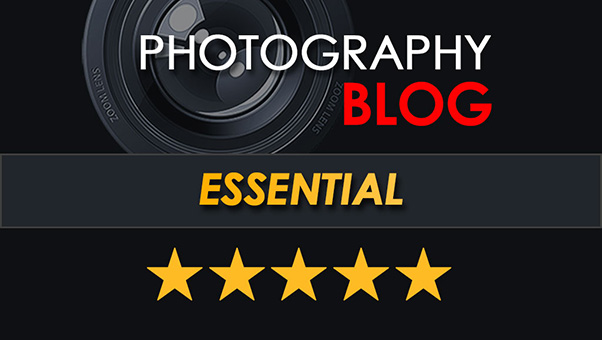
0 Response to "Nikon D5 Continuous Shooting With External Flash"
Post a Comment